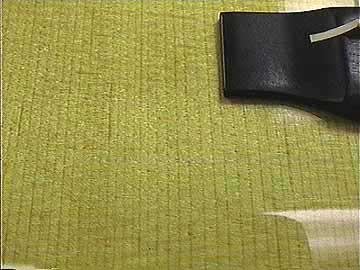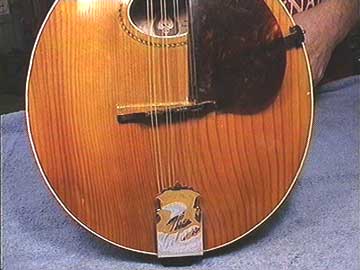Page 1 of 3
What wood you like?
Acoustic Guitar Tone Woods
© Frank Ford, 5/24/98; Photos by FF, 5/23/98
I'd like to say a few words about tone woods for acoustic guitars. My aim here is
to present a quick, cursory look at the woods used for guitar bodies, and to talk
a little about their performance. Please understand that this little article is just
a simple primer for folks who'd like a quick overview of the materials used in guitar
making.
Let's take it from the top.
Acoustic guitar tops are most commonly made of spruce:

Spruce is number one on the list of strength-to-weight ratio for all the woods
in the world.
So, for a given strength, a piece of spruce will weigh less. That's why it has
been used in aircraft, ship masts, and a variety of other structural situations.
A guitar top is a structural situation to be sure. The relentless pull of the strings
demands that the top of the guitar be very strong; the need for good resonance demands
that the top be as light as possible.
The next wood on that same list is cedar:

Not by coincidence, cedar is the second most popular top wood. Cedar looks a lot
like redwood: darker and reddish compared to spruce.
So, what do you get with each? In a general sense, I think you get slightly crisper
highs and a bit more power from spruce, and a little more mellow sound from cedar.
It gets tricky describing subtleties of tone, and I'll try not to get into too much
of that because there are so many variables.
There are lots of varieties of spruce, and each top will have differences in grain
pattern, stiffness, density, etc. That means my generalizations are just that. In
all cases it's best to hear the instrument and decide what you like! Any number
of instruments seem to break the rules.
Here's a generalization based on our observations at Gryphon, where we see lots
of new instruments from large manufacturers where top thickness and other factors
are very consistent:
IF ALL OTHER THINGS ARE EQUAL, that is, if we're talking about guitars of the
same model, size and detail of construction, by the same maker, with the same
neck angle, bridge height, top thickness, species of top wood, age, then it
appears:
A wide grain top will tend to produce stronger bass response:

That's because there are fewer stiff grain lines so the top is more flexible. From
the flexibility comes a lower natural resonant frequency and more easily produced
bass notes.
A narrow grain top will have comparatively stronger treble and more subtle bass:

This top has lots of hard grain lines, is much stronger and has a higher natural
vibrating frequency.
Here's a medium grain top:

Yes, it will tend to have a tonal response that's intermediate as well. Notice also
that this particular top has "stripes" of dark and light grain lines. Most
of us agree that color uniformity has no real bearing on the "quality"
of the top wood. Just a matter of appearance and personal taste.
What should you look for? Take your pick. Play lots of instruments and judge the
tone you like for yourself. Bear in mind that business of "all things being
equal." If you're going to try to predict the tone based on appearance you'd
better be talking about the same model made by the same manufacturer.
Individual luthiers, by the way, commonly take into account the stiffness of a
top and may use different thickness and or bracing for tops of different stiffness.
It's usually best to let the individual builder do his own thing. As a player, you
can just request tone, but it's not a good idea to try to tell the builder how to
achieve that!
Various species of spruce have been used for steel string guitar tops over the years,
and each have their devotees. I'm not going to get into speculating about predicting
the sound of individual species, partly because of the extreme difficulty in making
a positive identification.
Time for an anecdote:
I attended the A.S.I.A. Symposium in 1995 and saw a number of vendors selling guitar
tops in the exhibition hall. At dinner that evening I sat at a large table with Tom
Humphrey, the well known classical guitar builder. Tom was talking to one of the
spruce suppliers and describing how he had selected the Adirondack spruce (also known
as red spruce) tops he'd bought earlier.
I asked the vendor about his spruce, "Do you know why it's called 'red' and
how can you distinguish it from other spruce." He told me," I really don't
know. I can't tell it apart from other species. I just have to take the word of the
man who brings me the logs. He says it's red spruce."
Certainly there are general characteristics of color and grain
that help in identifying species, but these characteristics overlap to such an extent
that I really wonder if it's possible to make a positive identification of all samples.
Whatever the species they use most luthiers try to find top wood with as little grain runout as possible.
Other coniferous (softwood) species are sometimes used for guitar tops. We've seen
a number of redwood tops, and a few larch, fir and pine.
Some guitars are made with hardwood tops, such as mahogany. I've found that hardwood
tops tend to have less response at both ends of the spectrum, producing a guitar
with a very strong emphasis on midrange. Hawaiian steel guitars are almost always
made with koa or mahogany tops to give them their characteristic sweet, "mellow"
sound.
Before you go to the next page, and hardwoods for backs and sides, take a look at
this one:

It's a ninety year old Gibson mandolin with just about the most uneven looking spruce
grain I've ever seen in a good instrument's top. The two halves aren't matched at
all (not unusual for early Gibson mandolins, by the way) and the treble side has
the widest grain imaginable. And, wouldn't you know it, this instrument is exceptionally
good sounding, and there is not the least sign of structural failure in the top!
More
1
2
3
Back to Index Page





